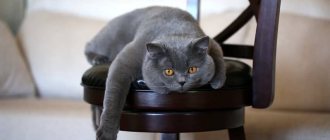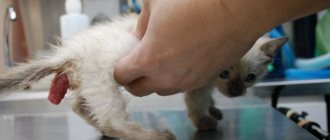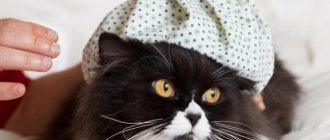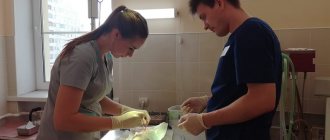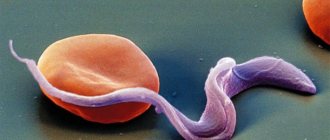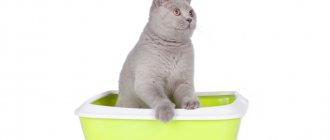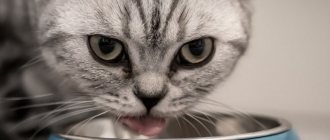4799Administration
A cat may have an upset stomach for a variety of reasons. The disorder may occur once and not occur again, or it may be chronic. At some point in an animal's life, digestive problems may arise.
Symptoms of indigestion can vary:
- decreased appetite along with vomiting, diarrhea, or constipation;
- increased or decreased feeling of thirst;
- dull and/or tousled coat;
- weight loss (in chronic situations).
© shutterstock
Digestive problems in cats can be acute or chronic. Acute gastric disorders are often self-limiting. Chronic indigestion requires a comprehensive veterinary evaluation to identify underlying causes and determine appropriate treatment.
Fecal parasite testing, complete blood count, feline leukemia and feline immunodeficiency virus tests, x-rays and/or ultrasound (if your pet is vomiting), and urinalysis and thyroid testing for more mature animals. Endoscopic or surgical biopsies may also be required in cases of chronic disorder.
If the disorder is accompanied by alternating diarrhea and constipation, vomiting that continues for several days, and such symptoms worsen, consult a veterinarian. This is important to prevent dehydration, infections, and liver or kidney complications. Veterinarians often give medications to relieve symptoms and also give intravenous injections to treat stomach upset and prevent dehydration.
Types of diseases and causes
The following gastrointestinal diseases most often occur in cats:
- Stomatitis occurs due to mechanical injury or infectious disease.
- Gingivitis is an inflammation of the gums that develops due to the unsuitable consistency of food, when particles stick to the gums and plaque forms.
- Gastritis is an inflammation of the stomach that occurs due to improper feeding or stressful situations.
- Gastroenteritis is inflammation of the intestines due to food poisoning, viral or bacterial infection, when inedible objects enter the digestive tube.
- Colitis is inflammation of the large intestine. Characterized by dysbacteriosis. It develops as a result of poisoning, the activity of intestinal parasites, infectious diseases, and side effects of medications.
- Intestinal obstruction occurs when the digestive tube is blocked by trichobezoars, helminths, bones, or an inedible object.
Major diseases
All diseases of the digestive tract are divided into infectious (colitis, coronavirus enteritis, gastritis) and non-infectious (constipation, cancer, intestinal obstruction, peptic ulcer, malabsorption syndrome). Let's take a closer look at each disease.
Colitis
Colitis is a disease characterized by inflammation of the large intestine. There are several reasons that lead to the development of the disease:
- Viral or bacterial inflammation.
- Parasitic infestations.
- Damage to the intestinal mucosa by a foreign body.
- Dietary disorder.
Clinically, colitis is manifested by local inflammation in the intestines (secretion of mucus and blood with feces, painful sensations) and intoxication syndrome (lethargy, refusal to eat and play, constant drowsiness).
Constipation
Constipation is a fairly common problem in cats. In this case, the pet rarely defecates; feces remain in the intestinal cavity for a long time and lead to intoxication.
Coronavirus enteritis
Coronavirus enteritis is an inflammation of the small intestine that occurs when exposed to a virus. The disease is infectious in nature and is transmitted by the fecal-oral route. A pet can become infected from sick cats that shed the virus in their feces. Kittens and older pets are more likely to get sick.
Gastritis
Gastritis is a disease characterized by inflammation of the gastric mucosa. The following reasons can lead to the development of gastritis:
- Poisoning (both chemicals and food).
- Dietary disorder (consumption of inappropriate foods).
- Hairball in the stomach.
- Taking certain medications.
- Allergic reaction.
Gastritis can occur in two forms: acute and chronic.
Bowel cancer
Colon cancer is uncommon in cats. It is a malignant tumor that is prone to unlimited growth and metastasis.
It is quite difficult to detect a tumor in the initial stage; most often it is an accidental discovery.
In the later stages, intestinal cancer is manifested by a significant decrease in body weight, lethargy, and apathy. Often, a cat is bothered by constipation and bleeding in the feces.
The prognosis in most cases is unfavorable, but depends on the detected stage and nature of the tumor.
Obstruction
Intestinal obstruction is an acute emergency pathology that, if not intervened in time, leads to death.
Something else interesting: Lice eaters in cats
The reasons that lead to the development of obstruction are as follows:
- foreign body;
- intussusception;
- adhesive disease;
- compression by tumor.
The disease can occur in two forms: complete or partial obstruction. Symptoms appear acutely: paroxysmal pain, vomiting, lack of passage of stool and gas.
Peptic ulcer
Peptic ulcer is a pathology of the stomach or duodenum in which ulcers form on the mucous membrane.
There are several reasons why the disease may develop:
- Infectious agents (including helminths).
- Taking certain medications.
- Reduced protective properties of the mucous membrane.
Peptic ulcer disease is a chronic disease, so periods of exacerbation alternate with periods of remission. All symptoms appear in the acute phase: severe pain, signs of gastrointestinal bleeding (vomiting “coffee grounds”, blood in the stool).
Malabsorption
Malabsorption is a condition characterized by impaired absorption of nutrients in the intestine. Malabsorption can occur for several reasons:
- Impaired secretion or function of digestive enzymes (diseases of the pancreas, gall bladder).
- Malabsorption in the small intestine (enteritis).
- Dysbacteriosis.
Clinically, malabsorption is manifested by prolonged diarrhea (sometimes foamy), an increase in the volume of excreted feces, weight loss (due to insufficient intake of nutrients), signs of hypoproteinemia and hypovitaminosis.
Clinical symptoms
The following pathological symptoms develop in various diseases:
- refusal to eat or decreased appetite;
- difficult to chew, painful to swallow;
- yellow or brown deposits on teeth;
- coating or ulcers on the tongue;
- salivation;
- stench from the mouth;
- vomit;
- constipation;
- diarrhea;
- bloating;
- untidiness of coat;
- aggression.
Depending on the cause of the disease, other pathological signs may occur.
Diagnosis and treatment
The cause of the disease is determined based on a clinical examination, anamnesis, as well as the listed laboratory or instrumental diagnostic methods:
- biochemical and general analysis of blood and urine;
- pathogen identification by ELISA, PCR;
- instrumental studies: ultrasound, radiography, colonoscopy.
First aid is provided when no additional pathological symptoms are detected.
When a cat has difficulty chewing or swallowing, inspect the mouth and switch the pet to soft food. If the animal has consumed dry pellets, they are soaked or temporarily replaced with wet canned food from the same company.
With natural feeding, solid pieces are ground to a puree. If erosions or ulcers are found, contact a veterinarian.
Limit consumption until the pet’s condition returns to normal. The daily dose is divided into small portions, so the cat is not forced to eat everything. Uneaten food is thrown away to prevent it from going sour.
When vomiting occurs, you should pay attention to its frequency, color and consistency of the contents. If the urge occurs more than three times a day or does not stop the next day, veterinary attention is required. You cannot self-prescribe antiemetic drugs.
When vomiting is accompanied by diarrhea, measures are taken against dehydration. Ringer-Locke solution is administered subcutaneously in unlimited quantities until the desired result is obtained or a veterinarian appears.
The release of a hairball is a favorable sign: the pet swallowed a hair while licking itself. And now they are out.
If constipation occurs, the kitten can be given a baby microenema. Rectal administration of medication to an adult pet without a veterinarian is unacceptable. Constipation can often be relieved by using oil laxatives. Castor or other vegetable oil helps the stuck lump of food slide out. However, fats are absorbed by the body and overload the liver. Therefore, you should use Vaseline oil. The mineral component enhances peristalsis, but is not broken down by the animal’s digestive enzymes.
In some cases, indigestion develops during long-term antibiotic therapy or as a postoperative complication. In such a situation, probiotics or prebiotics help.
If the actions taken do not bring the desired result, seek veterinary help. Conservative treatment is practiced, in which medications are used to eliminate the underlying disease. If there is a suspicion of intestinal blockage with food masses, a foreign object, or intussusception, the problem is eliminated surgically.
If gingivitis occurs or tartar has formed, you should contact your veterinary dentist.
How to treat stomach upset in cats at home
Of course, the optimal solution is a visit to the clinic, but there are situations when the owner does not have such an opportunity. What to do if a cat or an older kitten has an upset stomach, for example, at your dacha? How can you help your pet at home?
Diet and drink
Don't try to tempt your cat with tasty food in hopes that he will eat. You should only leave a bowl of clean drinking water.
If you experience repeated vomiting and diarrhea, you should be wary of dehydration. In this case, it is best to drink special solutions, such as Regidron, which are sold in a regular pharmacy.
The contents of 1 sachet should be diluted in 1 liter of water and given to the animal as often as possible from a syringe without a needle, 5-10 ml.
Sorbents
Sorbents, which can most often be found in a home medicine cabinet, will help reduce fermentation processes, soothe irritated gastric mucosa, neutralize toxins and normalize stool.
It is best to use Smecta. 1 sachet is diluted in 100 ml of water and drunk in small portions throughout the day: 5–10 ml for an adult cat, 1–2 ml for a kitten 4–5 times a day. You can also take Enterosgel, first diluting it with water to a liquid consistency.
Probiotics
When the animal gets better, you should start giving it food in small portions, but not earlier than a day after the symptoms appear. It is useful to drink probiotics, such as the veterinary drug Vetom 1.1 (dose for an adult cat - 1/10 of a sachet) or another probiotic for animals.
If no veterinary drugs are available, human drugs can be used. The easiest way to dose liquid probiotics, for example, the dose of Hilak Forte for an adult cat is 3-5 drops 3 times a day.
These measures can also be used as first aid if you feel unwell, even when a further visit to the clinic is planned.
Prevention
The optimal solution to the problem of gastrointestinal diseases is the use of ready-made food of at least premium class. They contain components that cleanse the gums of food debris, probiotics and prebiotics that normalize digestion, and plant fibers that help remove ingested hair from the body.
To prevent infection of animals with ectoparasites and worms, insectoacaricidal drops Spot-on or separate products are used. They protect against infections through immunization in accordance with the vaccination plan. For natural feeding, dental bones, Phytomins for removing wool, or Malt paste are used. Long-haired pets are brushed regularly. They block the path to the trash can to prevent the animal from eating the sausage wrapper.
Read us also on VKontakte and Odnoklassniki. We invite you to our communities.
Inflammation of the gastrointestinal tract in cats
When the gastrointestinal tract is inflamed, so-called inflammatory cells penetrate into the stomach and intestines - cells formed in the body during wounds - lymphocytes and plasmacytes, responsible for the body’s immune reactions, eosinophils, neutrophils, responsible for cleaning damaged tissues. In chronic inflammation, normal tissue may be replaced by fibrous tissue.
Causes of gastrointestinal diseases in cats. The exact causes of pathologies of this kind in cats are unknown.
Genetic predisposition, feeding, various pathogens and a malfunction of the immune system may play a role. Inflammation of the gastrointestinal tract may not be a disease as such, but a characteristic reaction of the body to certain conditions caused by various factors.
GASTROENTERITIS
Gastroenteritis is inflammation of the stomach and small intestine. Catarrhal gastroenteritis (catarrh of the stomach and intestines) - develops in cats due to excessively greedy food intake and stomach fullness, and can also be observed with panleukopenia, salmonellosis, staphylococcosis, colibacillosis and some other diseases. Catarrhal phenomena also occur under the influence of one’s own intestinal microflora, which has become pathogenic due to exposure to unfavorable conditions. Most often, gastroenteritis is observed in kittens.
Symptoms: hot and red mouth, warm and dry nose, decreased appetite or extreme picky eating, fever, extreme thirst, constipation and depression. Catarrh of the stomach is often accompanied by vomiting, while the stomach is painful and sensitive to the touch. With intestinal catarrh, these phenomena are absent, while with damage to the duodenum, diarrhea appears and the urine turns bright yellow. Feces with catarrhal inflammation are liquid, watery, fetid, mixed with undigested food and mucus.
First aid and treatment: rest and a gentle diet. For 1-2 days, do not feed the cat, give only water or herbal decoctions and infusions, administer Gamavit subcutaneously, give Vetom-1.1, Lactoferon, Polysorb on an empty stomach for 5-7 days. In the future, feed with nutritious meat food. It is best to feed raw, low-fat meat.
Phytotherapy. Among the plants recommended for preparing herbal decoctions and infusions for gastroenteritis are marshmallow root, string, oak bark, sage leaves, and chamomile. A cleansing tea is also indicated.
A number of herbal mixtures are used. 1. Common fennel (fruit) 25 g, marshmallow (roots) 25 g, chamomile (flowers) 25 g, licorice (root) 25 g. 2. For the prevention and treatment of acute gastroenteritis: chamomile, flowers - 2 tsp., silver birch, buds - 2 tsp., large burdock, roots - 2 tsp., large plantain, leaves - 1 tsp., common yarrow, grass - 1 tsp., coltsfoot, leaves - 1 tsp. , Scots pine, buds - 1 teaspoon. Brew one tablespoon in a glass of boiling water, boil over low heat for 25-30 minutes, cool for 10 minutes at room temperature, drain. Squeeze out the remaining raw materials and add boiled water to 0.2 liters. Give the decoction warm 3 times a day 20-30 minutes before feeding. After 15-20 minutes, make a microenema from the same decoction once a day in a volume of 10 ml. The therapeutic dose of the decoction for cats is 8-10 ml, prophylactic - 4-5 ml. (according to I.V. Sidorov, V.V. Kalugin et al., 2001). 3. For the prevention and treatment of chronic gastroenteritis: St. John's wort, herb - 3 parts, large plantain, leaves - 2 parts, chamomile, flowers - 1 part, yarrow, grass - 1 part, common oak, bark - 1 hour. Brew one tablespoon in a glass of boiling water and leave for 15 minutes. Give the infusion 3-4 times a day 20-30 minutes before eating. Microenemas from the same infusion are recommended once a day in a volume of 10 ml. The therapeutic dose of infusion for cats is 10-12 ml, prophylactic - 5-6 ml (according to I.V. Sidorov, V.V. Kalugin et al., 2001).
Symptoms
All diseases of the gastrointestinal tract are united by common symptoms, by which you can easily suspect that your pet has disorders in the bottom area:
- Stool disorder - diarrhea or prolonged constipation should alert the owner, especially if this condition lasts more than 2 days or is constantly repeated at short intervals.
- Vomiting usually indicates damage to the stomach. You should definitely take your pet to a doctor if there is uncontrollable vomiting.
- Loss of body weight.
- Changes in appetite – either an increase or decrease in appetite may occur.
All of the above symptoms serve as a signal to contact a veterinarian.
Clinical tests
For diseases of the gastrointestinal tract, it is mandatory to submit a stool test for helminths and scatology. This will help identify parasites and suspect digestive disorders.
X-ray examination using contrast helps to identify areas of obstruction, the presence of tumors and foreign bodies.
Ultrasound allows you to diagnose diseases as accurately as possible and accurately establish a diagnosis.
For infectious diseases of the gastrointestinal tract, culture of vomit, gastric lavage and feces to determine the pathogen
Treatment and prevention
The basis for success in the treatment of diseases of the gastrointestinal tract is a therapeutic diet. Most problems can be resolved by improving your pet's nutrition. It is advisable to consult with your veterinarian about feeding options so that it is appropriate for the age and breed of your cat.
You should not give too cold or hot food; the diet should include lean meats, cereals, vegetables and dairy products. The easiest way is to select high-quality ready-made foods that are specially balanced and have the necessary set of nutrients. Do not mix natural food and ready-made food.
Digestive problems often lead to malabsorption, so additional parenteral vitamins are recommended during treatment.
Inflammatory diseases require medical support; antibiotic therapy, herbal decoctions and enveloping drugs are required.
In order to prevent diseases of the stomach and intestines, you should carefully monitor your pet’s diet. Avoid eating expired or low-quality food. Do not allow your cat to have access to the trash can and eat scraps, and avoid drinking from untested sources (puddles, toilets, natural springs).
Do not underestimate problems with the gastrointestinal tract in your pets; timely contact with a specialist will greatly facilitate the treatment of the disease and eliminate the possibility of developing chronic stages of the disease.
Causes of intestinal blockage
It is impossible to determine the root cause at home, since this research requires special equipment.
The cat is taken to the veterinarian so that he can identify the factor that caused the intestinal obstruction. The most common causes of intestinal blockage in cats include:
- Foreign objects that animals swallow during play through carelessness or curiosity. Most often these are scraps of thread, tinsel, sausage casings, small rubber or plastic parts. The foreign body travels down the esophagus, but gets stuck in the small intestine and clogs the organ.
- Hairballs swallowed as a result of licking. The risk group includes long-haired individuals who take special care of themselves. Over time, the number of hairs accumulates, mixes and turns into a lump. It gets stuck and creates an obstruction. Outdoor cats can get rid of the problem themselves by eating grass: it causes vomiting and release of the body. It’s more difficult for domestic cats: they need to wait until the owner brings or plants grass in the apartment.
- Intestinal parasites can, with prolonged infection, cause intestinal obstruction in a cat. An increase in the number of worms leads to their accumulation in a certain area. They intertwine into a lump, which greatly interferes with the passage of feces. This can be prevented by regularly using anthelmintic drugs.
- Chronic constipation. An incorrect diet can cause defecation problems in your pet. The excrement becomes hard and therefore does not pass well through the intestines. Weak peristalsis is also the cause of the formation of fecal plugs. The result of constipation is intoxication of the body and, in some cases, obstruction. Properly selected food and following the recommendations of a veterinarian will prevent the development of an unpleasant disease.
- Tumors of various types. Benign and malignant neoplasms obstruct the passage of digested food and provoke stagnation.
- Intestinal volvulus, in which the body does not cleanse itself. The area of the intestine becomes pinched, and the tissue on it gradually dies. As a result, rapid intoxication and death of the pet occurs.
It is impossible to independently identify the cause of the pathology - this can only be done by a specialist in a veterinary clinic. Treating someone without a doctor’s prescription and delaying visiting a veterinary hospital is dangerous for the patient’s life.
Nonspecific bowel disease in cats (Inflammatory bowel disease)
(c) Veterinary center for the treatment and rehabilitation of animals “Zoostatus”.
Varshavskoe highway, 125 building 1.
Nonspecific inflammatory bowel disease (IBD)
is a group of diseases for which the sole cause is unknown. IBD results in inflammation of the intestines, and animals affected by the disease experience chronic symptoms. Siamese cats are the most predisposed to IBD.
The condition of inflammatory bowel disease is characterized by the presence of specific inflammatory cells in the intestinal lining. In IBD, lymphocytes and plasma cells are found, which are directly responsible for the body's immune response. Eosinophils are usually another cell type present at the site of inflammation. Neutrophils are responsible for destroying foreign bacteria or cleaning up damaged tissue. In chronic disease, normal intestinal epithelial tissue can be replaced by scar tissue.
Gastritis in cats
As many people know, gastritis is an inflammation of the mucous membranes of the stomach. All types of gastritis can be divided into three main types:
- Hyperacid. Accompanied by a decrease in the pH of gastric juice.
- Hypoacid. At the same time, the pH rises and the stomach environment becomes alkaline.
- Anacidic. The most dangerous type. The pH reaction approaches neutral, which is why digestion and disinfection of food does not occur; the food simply rots in the cavity of the organ.
In addition, gastritis can occur in acute or chronic forms. It is interesting that in cats, due to the non-obvious and hidden symptoms of the disease, inflammation very often turns into a latent form, which greatly complicates further treatment (or even makes it impossible/ineffective).
The causes of gastritis are very diverse; simply listing them could take a couple of pages. Let us note, however, that in cats the main cause is poor quality nutrition, poisoning, as well as the action of Helicobacter pylori bacteria (which, in addition, cause stomach ulcers).
Symptoms
Let us immediately note that it is difficult to judge the presence of gastritis in a cat based on the clinical signs described below, since these animals may not have pronounced symptoms. But when observing an animal you can notice:
- With gastritis, cats very often begin to vomit approximately 10-15 minutes after eating.
- In cats, hyperacid type gastritis most often occurs, one of the manifestations of which is constant and causeless constipation (even with a completely adequate diet).
- During exacerbations of gastritis, a strong pain reaction develops, which is why the cat often refuses food.
Symptoms of the disease:
Symptoms of nonspecific intestinal inflammation in cats:
Signs may vary depending on the part of the tract in which the inflammation occurs. For example, vomiting is more common when the stomach or upper small intestine is involved; diarrhea occurs when the colon is involved. At the initial stage of the disease, there is an increase in the volume of bowel movements, but each time the amount of stool is produced less, blood appears in the stool. Diarrhea and vomiting may be intermittent (come and go). In severe conditions, some animals become depressed, stop eating, and an increase in body temperature appears.
Main symptoms
Signs of the disease in the early stages are not characteristic of gastritis. Rather, the disease manifests itself as general intoxication:
- the cat becomes lethargic, inert, does not play, constantly lies down, sometimes hides from people, hiding under furniture or hiding in far corners;
- the animal loses its appetite, often completely refusing to eat, and does not even respond to the favorite treat offered;
- the cat’s body temperature may rise slightly, but sometimes this indicator may not be present;
- a sick pet shows unusual thirst, drinks much more and more often than usual.
As the disease develops, there may be periods of improvement and deterioration, as well as the following signs:
- significant loss of body weight;
- vomiting, sometimes mixed with blood and/or bile, after eating;
- acute reaction of the cat to touching the stomach;
- the presence of a grayish coating on the tongue, bad breath;
- changes in the nature of stool: with gastritis with low acidity, diarrhea is observed, and with increased acidity, constipation is observed.
During an attack, the animal takes a characteristic pose with its front paws widely spaced and its head bowed. If such symptoms are observed, the cat should be taken to the clinic immediately.
Diagnosis of intestinal inflammation in cats
To make a correct diagnosis, your veterinarian will need to take a detailed medical history of your cat and ask you questions regarding the duration and frequency of symptoms.
In some animals, thickened intestine may be palpable on physical examination.
The test result (urinalysis and clinical, biochemical blood test) is often normal. Some cats may have anemia and a high number of white blood cells (leukocytes) (as with infections). Increases in protein and liver enzyme levels may also be found, as... If the intestines are severely inflamed, the liver and pancreas may also be affected. An increase in the number of eozonophils in the blood is also possible.
X-ray and Ultrasound: There are no consistent radiological findings in a cat with IBD. The intestines may become thickened and contain more gas than normal intestines, but these signs can also occur with other illnesses.
The only reliable way to diagnose bowel disease is to perform a biopsy, but even then it can be difficult to distinguish from some types of cancer. A biopsy will show an increase in the number of inflammatory cells in the intestinal wall. Cell types can help determine what type of bowel disease is present. A biopsy can be obtained through the use of an endoscope or during exploratory laparatomy (surgery). The intestines may appear normal to the naked eye, but changes can be seen under a microscope. In other cases, gastrointestinal lesions are quite obvious.
Other causes of diarrhea or cellular infiltrates should be excluded (fecal protozoan testing, culture to rule out salmonella, for example, blood tests to rule out underlying conditions such as hyperthyroidism, liver disease, or feline leukemia virus (FeLV) infection).
Other predisposing factors
Unfortunately, bad or inferior food is far from the worst cause of dyspepsia. Other predisposing factors can lead to pathology, some of which are deadly in themselves:
- Inflammation of the pylorus of the stomach, which disrupts the process of gastric digestion.
- Inflammatory processes in the small and large intestines (enteritis, colitis).
- Stomach or duodenal ulcer.
- Putrefactive dyspepsia in kittens is a consequence of congenital immunity to lactose (milk sugar). Such animals are doomed if they are not fed with special nutritional mixtures from infancy.
- Diseases of the liver and gall bladder (hepatitis, cholecystitis).
- Severe stress.
- Some medications can cause dyspepsia: aspirin (which is generally fatal to give to cats), many antibiotics, steroids, digoxin and theophylline.
- Swallowing air while greedily eating food.
- Stomach or intestinal cancer.
- Pancreatitis (inflammation of the pancreas). In particular, fermentative dyspepsia often appears against its background.
Treatment of intestinal inflammation in cats
Typically, treatment for inflammatory bowel disease involves a combination of diet and the use of various medications. A hypoallergenic diet is one of the first steps to verify the diagnosis. The key is to use sources of protein and carbohydrates that the cat has not eaten before, such as duck, potatoes, or use a diet consisting of hydrolyzed proteins.
Eliminate various treats and treats.
If this diet helps, its duration is two weeks.
If a hypoallergenic diet is ineffective, others are involved. Highly digestible, low-fat diets are generally better tolerated by a cat with IBD. Avoid: wheat, rye, oats and barley! You can use homemade diets, but developed by veterinary nutritionists.
Of course, with such an abundance of diets, you will have to be patient and monitor your pet for a long time until there is a noticeable improvement in the condition.
The most common mistake in treating IBD is stopping treatment too early.
- Prednisolone, dexamethasone, budesonide help reduce symptoms.
- Azathioprine and cyclophosphamide are alternative immunosuppressants generally used only when other treatments have failed.
- Metronidazole is an antibiotic used to reduce the number of bacteria that could cause the disease.
- B vitamins
- For cats with symptoms of IBD, deworming is recommended, often necessary to treat underlying parasitic infections in the intestines that cannot be diagnosed based on standard fecal examination.
Some studies have shown that diets enriched with fatty acids can reduce inflammation in the GI tract.
- Prebiotics help change the intestinal environment and stimulate the growth of beneficial bacteria. Prebiotics are sources of these beneficial bacteria.
- In some cases, antispasmodic drugs are used.
Treatment for indigestion in cats
The condition, which manifests itself symptomatically as indigestion, can occur with many other life-threatening pathologies.
Repeated vomiting, lethargy of the animal, or constipation or diarrhea are reasons to contact the clinic as soon as possible. If indigestion is caused by any general medical condition, treatment will be aimed at eliminating the root cause. If tests and examinations do not show pathologies of other organs or infections, then symptomatic therapy is carried out, which includes the following main points with various variations:
- starvation diet for 24 hours;
- injections of antiemetic drugs;
- oral administration of sorbents;
- in case of dehydration - infusion therapy.
After the condition has stabilized, the doctor usually prescribes a therapeutic diet, small meals, probiotics, and also explains to the owner the basics of proper feeding.
Quick help and properly prescribed treatment for indigestion in cats can avoid many health problems. The main prevention of this unpleasant phenomenon is only proper nutrition of the pet.
Prognosis for cats with VKD
Inflammatory bowel disease can only be controlled, not cured. Usually the prognosis in cases of severe illness is poor.
Be patient with the form of treatment suggested by your veterinarian and strictly adhere to the recommendations. Control depends on the correct selection of diet, dosages of medications, careful monitoring by the veterinarian and owner, and the absence of other concomitant diseases.
Read reviews about our veterinary center. Call the number and schedule a consultation right now or request a call back. (c) Veterinary center for the treatment and rehabilitation of animals “Zoostatus”. Varshavskoe highway, 125 building 1.

